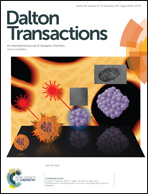Conformation-selective coordination-driven self-assembly of a ditopic donor with PdII acceptors†
Abstract
Coordination-driven self-assembly of 3-(5-(pyridin-3-yl)-1H-1,2,4-triazol-3-yl)pyridine (L) was investigated with 90° cis-blocked Pd(II) acceptors and tetratopic Pd(NO3)2. Although the ligand is capable of binding in several different conformations (acting as a ditopic donor through the pyridyl nitrogens), the experimental results (including X-ray structures) showed that it adopts a particular conformation when it binds with 90° cis-blocked Pd(II) acceptors (two available sites) to yield [2 + 2] self-assembled macrocycles. On the other hand, with Pd(NO3)2 (where four available sites are present) a different conformer of the same donor was selectively bound to form a molecular cubic cage. The experimental findings were corroborated well with the density functional theory (B3LYP) calculations. The tetratopic Pd(NO3)2 yielded a [6 + 12] self-assembled Pd6L12 molecular cube, which contains a potential void occupied by nitrate and perchlorate ions. Being a triazole based ligand, the free space inside the cage is enriched with several sp2 hybridised nitrogen atoms with lone pairs of electrons to act as Lewis basic sites. Knoevenagel condensation reactions of several aromatic aldehydes with active methylene compounds were successfully performed in reasonably high yields in the presence of the cage.


 Please wait while we load your content...
Please wait while we load your content...